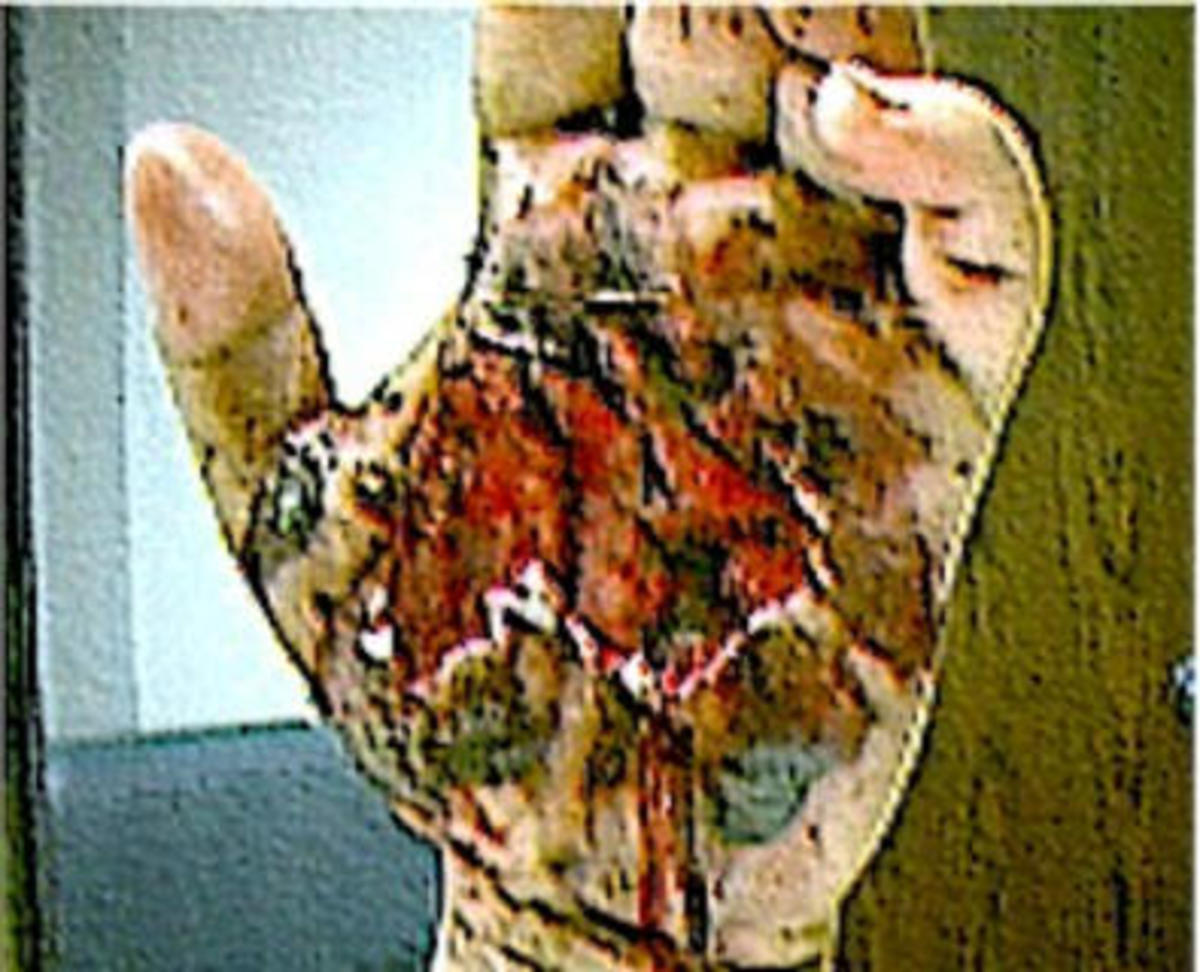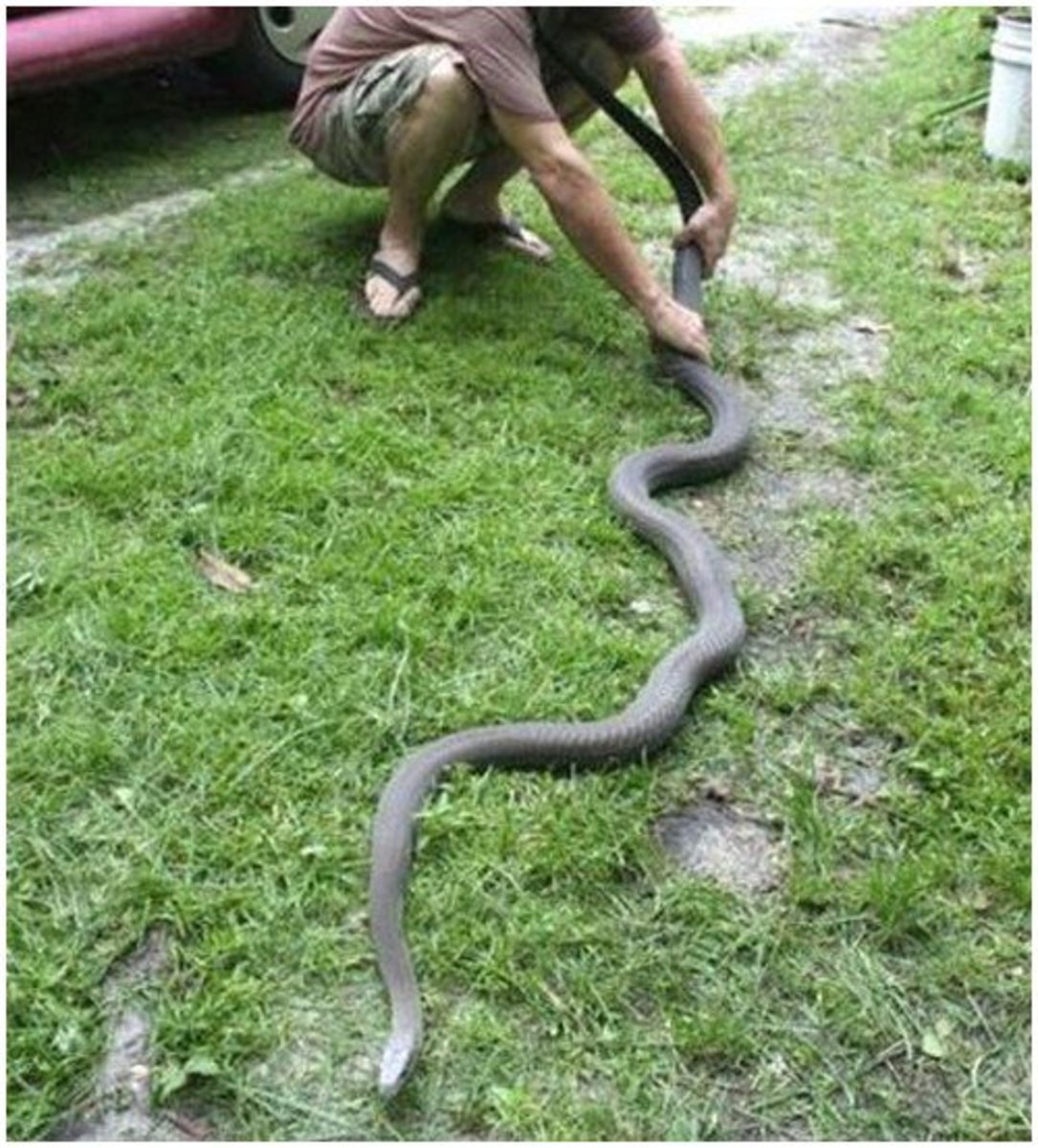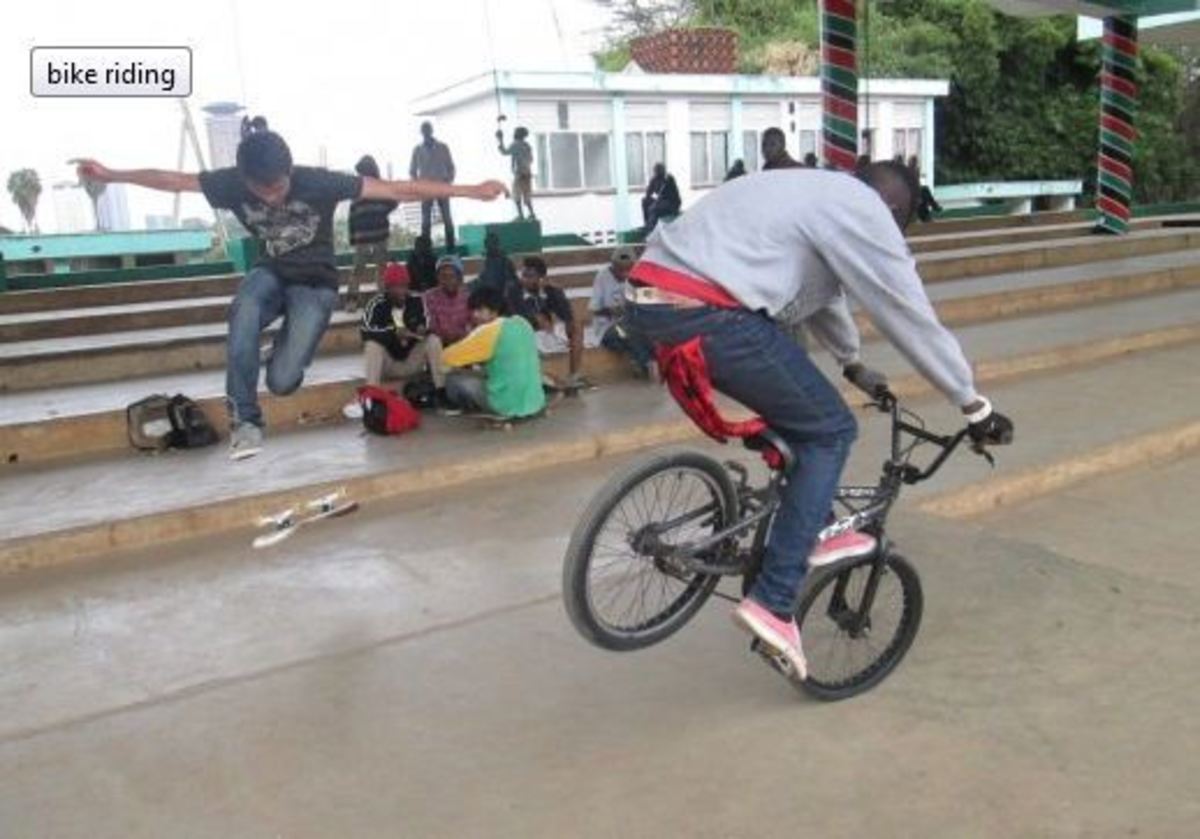A Childhood in Africa
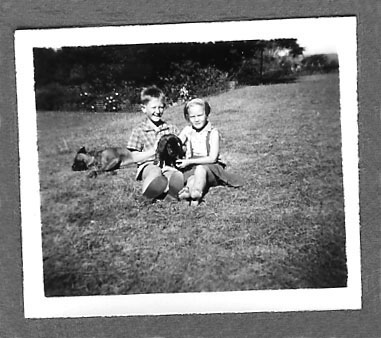
Childhood Memories of Africa in the 1950s and '60s
I was born and brought up in a small town named Kitale in the foothills of Mount Elgon in north western Kenya. My father owned a property which grew crops such as coffee, maize and sunflowers. There was also a Jersey dairy herd with pig and cattle fattening units, as well as other kinds of livestock. This was a real mixed farming enterprise, and the prize possessions were several large oxen which were the 'tractors' of those days and did all the ploughing and heavy field work.
My sister, Ali and I were living in this beautiful country surrounded by rich, productive land with a glorious flora and fauna on one hand, and deadly snakes and other wild animals on the other. We played with the local African children who taught us how to shoot homemade catapults and bows and arrows with fearsome accuracy, and learnt how to catch flying ants from underground - and then eat them!
I had a taste of a very, very special place. Here's my story.
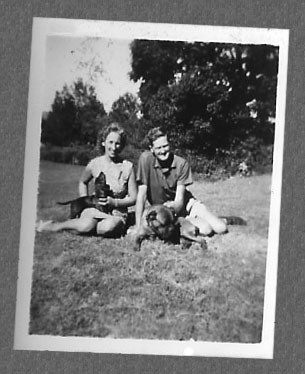
My Parents
Enjoyed the African lifestyle AND the sun!
My father went out to Kenya as a young man in 1946 to work on his uncles farm. He soon found that this was the life for him and wanting to learn about local farming techniques embarked on an agricultural course.
After completing this, he was given some land to farm by his uncle, but there was no house with it. With the help of a few locals, he set about the task of sourcing most of the materials from the wild, and over the course of a year built one.
Now with a house of his own and a farm, and ready to move on in life he married my mother in 1952. She had been waiting for him for many years, as they had been childhood sweethearts when they lived in a small town in Northern Ireland. Their African adventure was now under way.
Dad then went into partnership running a mixed farm for a few years, before finally moving and settling in Kitale, where my sister and I spent 10 very happy years. Apart from running a farm, my father was also in charge of the Scouting Movement. Groups of scouts used to spend time being taught survival skills and other scouting attributes whilst camping around the farm. This is how I learnt so many valuable skills from him, so I consider myself fortunate to have been influenced by an expert - who was also my dad.
Dads First House
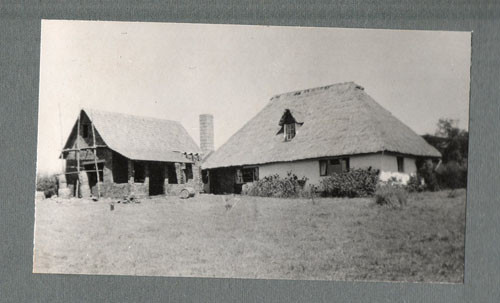
Kenya Stuff on Amazon
Some of My More Memorable Experiences
A Little Boys Lasting Memories
Spitting cobra incident.
On the farm was a large unit housing laying hens. All the laying boxes were in line roughly at shoulder height off the ground which made egg collection easier.
One day my father was collecting the eggs and as he proceeded down the hen house he failed to notice that one of the boxes contained a spitting cobra. As he stretched out his arm the cobra spat at him - aiming for the eyes - but fortunately the leaning motion caused him to bow his head slightly, and the venom flew past landing on the wall behind. A very near miss, but one likely to make him check in future.
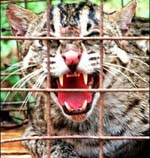
Civet cats attacking chickens.
Another menace in the hen house was the civet cat; they were the fiercest animal I remember seeing at close up. They used to wreak damage and kill hundreds of hens for fun, rather like a fox does. This meant that in order to halt this carnage large traps had to be set to capture these animals. A captured civet cat lets out the worst shrill I have ever heard - I can still hear it in my head today.
Civet cats are fairly small, 17-28 inches in length, and are more related to the mongoose than to any cat. It is also a fruit-eating mammal which proves that killing the hens was pure sport, nevertheless an animal that left a lasting impression with me.
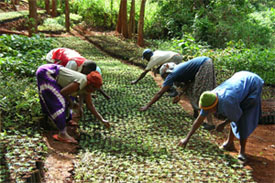
African women working and singing.
A lovely lasting memory is of the African women dressed in their colourful dresses and layers of beads around their necks beating the corn with flailing sticks, working in the fields and picking coffee.
Whilst working, often with babies tightly tied behind their backs, they would sing and chant harmonious songs - it showed that singing while you work takes the mind off the job. They were always very happy and laughed a lot, a great sight to behold. Their sense of humour was infectious.
These women never get back ache even though they are bent double most of the day!
Homemade catapult.
Any small boys pride possession at the age of about 8 or 9 would be a catapult, but to have one that had been beautifully crafted from a piece of tree branch and then fitted with a strip of bicycle inner tube and rough cow leather was just magical.
Once I got hold of my catapult I was taught how to use it with amazing accuracy. The locals would be able to shoot down a fruit-stealing mousebird with just one shot or hit a tin can at 20 paces with no trouble.
What was more important to me was that I teamed up and played with all the local kids while our fathers all worked on the farm.
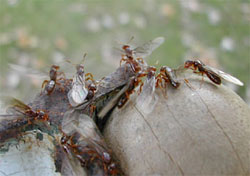
Catching flying termites.
Flying ants only came out of their termite when it was raining, and as the local kids all loved to eat them, they devised a way of enticing them out although there was not a raindrop in sight.They would build a funnel shaped trap over the entrance to the mound so as the termites flew out they could be easily caught. But the way they enticed them out was enthralling.
By placing a large log right beside the termite mound, they would beat on the log with sticks. The termites thought that the rains had come so flew out of the mound only to be trapped by the banana leaves covering the trap. This is the bit you might find a little squeamish - they (and me) pulled off the wings and ate them live, by the dozen. It sounds awful, but as a good source of protein, the practice had been going on for generations.
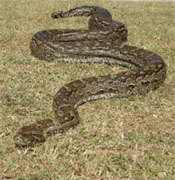
Python under the carpet.
One evening my sister and I were getting ready for bed, we walked through my parents room towards their bathroom. On our way through I noticed a large bulge under their carpet and immediately called my father.
When he arrived he told me to go and get a golf club from the far end of the house, a driver I recollect! On returning, us kids were sent back to our room whilst my father waited - as if preparing to tee off the first hole - for the movement to appear out of the edge of the carpet.
Then there was a thwack! The deed was done, it was a huge python. A few local lads were summoned to pull out the snake, and despatch it into the garden.
We later found out that the locals don't mind handling live snakes, but they really hate handling dead ones - superstitious no doubt!
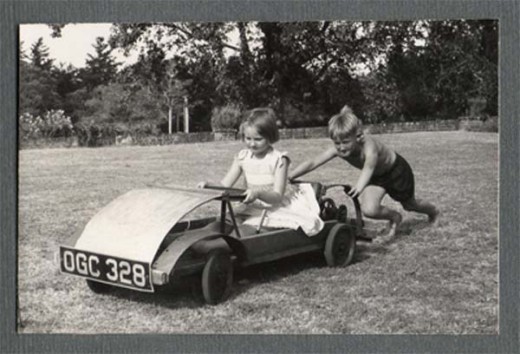
Our Go-Cart
Why am I doing the pushing?
A relation kindly gave my sister and me this stylish 1960s 'formula one' go-cart. It was powered by a lawnmower engine and gave us, and all our school friends, hours of endless fun.
I cannot understand why it needed pushing, perhaps the two-stroke had to be bump started!
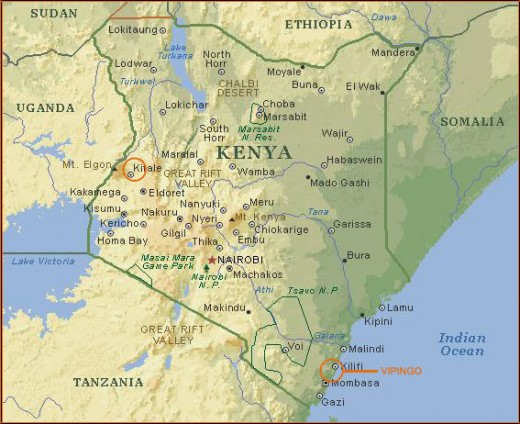
Holiday Time - Kitale to Vipingo via...
Approximately 600 miles over 2-3 days
Our journey from Kitale to the coast at Vipingo took two to three days driving with a nights stop around Nairobi or at the famous Tsavo National Park.
We were so excited here as we saw so many wild animals in their natural habitat, while some including hyenas got too close to us at nighttime. They would come after dusk and poke around outside our hut occasionally making off with a pair of shoes or something similar. In fact, hyenas will eat almost anything! Their bark sent a chill down our spines as noises at nighttime always frightened us.
In the cool of the night, in Africa, the plains come alive as the predators seek their prey, so it is no wonder that children in a simple hut would be scared.
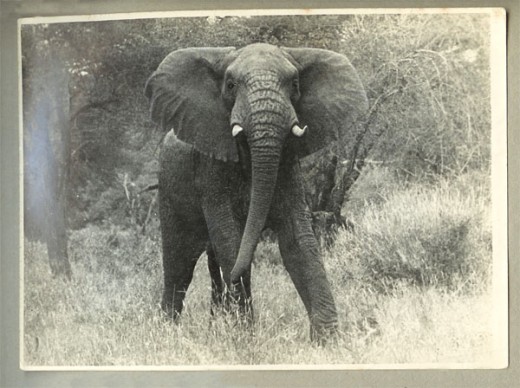
The elephant really is that close!
I have treasured this photo as it was taken by my great uncle before the days of telephoto or zoom lenses. He was one of the last original White Hunters in Kenya who took clients out hunting BUT only on foot and with only one or two local accomplices with spears. Many individuals were killed by rhinos and elephants.
Imagine being cornered by an angry, shortsighted rhinoceros with the only possible escape route being up a tree - and probably a thorn tree at that!
Animal Carvings on Amazon
...Tsavo National Park
We soon arrived at Tsavo National Park which is located in southeastern Kenya, east of Mount Kilimanjaro. Established in 1948, it covers 8,036 sq mi (20,812 sq km) and is Kenya's largest national park.
The park is divided into two smaller areas for administrative purposes: Tsavo East and Tsavo West. It is made up of semiarid plains covered by dormant vegetation (which will bloom after a light rain) and acacia (thorn trees) and baobab trees. There is plenty of wildlife in the area which includes elephants, lions, wildebeests, rhinos, hippos, and hundreds of bird species. Unfortunately, poaching is endemic, and brush fires are constant problems.
Tsavo consists of 10 million acres of pure wilderness. It incorporates open savannah, hills and ranges, brush and afforested areas of acacia and montane forest, and also an extensive river system.
The sheer size of Tsavo gives anyone the opportunity to get away from it all, and explore the wild in complete solitude. Taking a safari here, you will see large herds of Elephant, often covered in dust and looking a reddish colour, as well as Lion, Buffalo, Eland, Giraffe Impala, Kudu and maybe Rhinoceros.
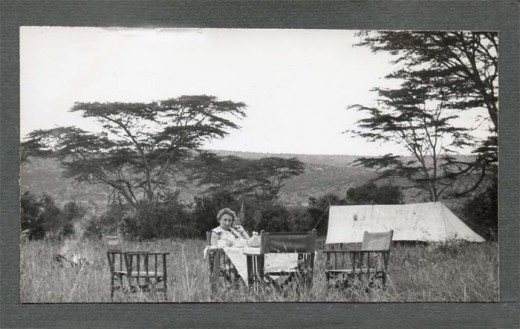
Campsite in Tsavo
This really is 'Out of Africa'
My mother in front of the canvas scouting tent. I remember this tent weighing a tonne, I don't know how my father put it up on his own - perhaps he had some local help!
During the night, we had many visitors including the scavenging hyenas and of course the chorus of the wild.
The Lions of Tsavo
One of Africa's greatest adventure stories
The Lions of Tsavo on display
The vast plains of Tsavo are crossed by the main Nairobi-Mombasa railroad. This historic railway was, in 1899, the scene of one of Africa's greatest Adventure stories.
Two large lions actively preyed on the railway workers as they built a bridge over the Tsavo river, claiming over 120 railway workers. They evaded hunters for well over a year while crews tried to scare off the lions by building campfires and thorn fences for protection, but to no avail. Hundreds of workers fled Tsavo, halting construction on the bridge and the legend of the Maneaters of Tsavo was born.
Before work could resume, chief engineer Lt. Col. John Henry Patterson (1865-1947) had to eliminate the lions and their threat. After many near misses, he finally shot the first lion on December 9, 1898, and three weeks later brought down the second. The first lion killed measured nine feet, eight inches (3 m) from nose to tip of tail. It took eight men to carry the carcass back to camp. The construction crew returned and completed the bridge in February 1899.
"Maneaters of Tsavo" Books - Read this amazing true story
...Mzima Spring in Tsavo
My memories of Mzima Springs are of a tranquil group of pools with hippos wallowing in the mud, yawning or fighting. The springs are an oasis in the hot plains with an incredible ecosystem.
Below is an excerpt from 'Kenya's Mzima Spring Comes Alive' by Mark Deeble and Victoria Stone.
----------
The word 'Mzima' means "alive." Yet the life of Kenya's Mzima Springs is largely born of ash and dung. In the neighboring Chyulu Range stand porous peaks of volcanic ash, whose youngest cones formed about 500 years ago. Rising 7,000 feet (2,000 meters) above an arid plain, these hills trap up to three feet (one meter) of rain each year from moisture-laden winds. All that rain soaks into the sponge-like ash and percolates down until it hits impervious bedrock and begins its underground journey to Mzima Springs some 25 miles (40 kilometers) away. Filtered over many years, the pure water gushes forth at a steady pace of more than 50 million gallons (190 million liters) a day, creating an oasis at the heart of Kenya's Tsavo West National Park. We camped there for two years with our two young sons, studying Mzima's hippos, whose copious deposits of dung nurture a pyramid of life.
by Mark Deeble and Victoria Stone
Read the rest of the article here...
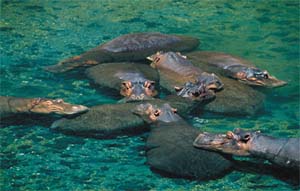
Sheer Bliss at the Coast near Mombasa
Vipingo Beach
Every summer we drove approximately 600 miles from the farm to the gorgeous Kenya coast at Vipingo, just north of Mombasa. This beach was always deserted apart from the lone shell hunter, who would wander slowly with keen eyes trying to find the beautiful leopard cowrie shells amongst several other types.
The quiet beach has a wonderful white sand and sparkling crystal clear water, just what young children desire. But before we were allowed in for a swim at high tide in the early afternoon, my best friend Johnny and I had to endure an hours maths cramming. To this day I thank Bridget, (our maths tutor and family friend) for her clever way of teaching by making maths fun.
Anyhow, back to the beach or Indian ocean as it really is with its reef only a few hundred metres away.
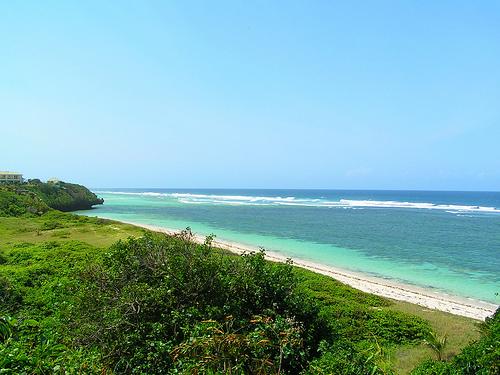
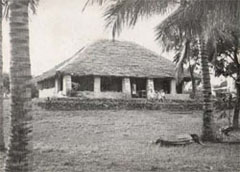
Our beach house
With our maths done, the highlight of the day had arrived, a swim in the ocean at high tide. With huge rollers coming in, it was the most idyllic place to be - it was paradise on earth for little children. The turquoise coloured water was so warm, which meant that we stayed in for hours on end, surfing, swimming and splashing. Meanwhile, the adults read their books and chatted away while resting on the softest of soft sand, under palm trees, with crabs busily racing back and forth to the background roar of rollers crashing on the reef.
Where else would you want to be?
Masai Women Cooking
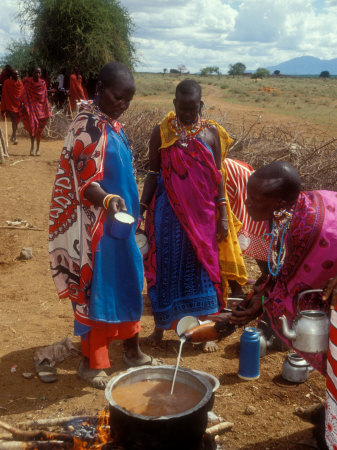
Masai Women Cooking for Wedding Feast, Amboseli, Kenya by Alison Jones
The Masai Tribe - They live on the border of Kenya and Tanzania.
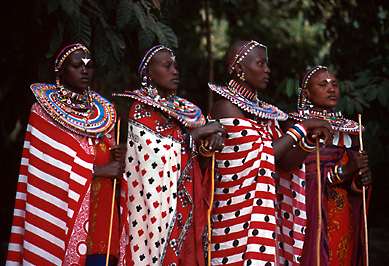
Masai women wearing brightly colored clothes with intricate beadwork around their necks.
The Masai are seminomadic tribe from northern Kenya who exist entirely off their cattle. They live in simple mud huts which are built out of sticks and dried grass and plastered with a slurry mix of dung and mud. This dries and hardens rapidly forming a watertight skin, this process is repeated annually.
The huts are assembled within a small field (called a 'boma'), and the boma is surrounded by a natural fence made out of thorn tree branches which also contains the Masai's animals at night time, protecting them from marauding predators.
As Masai boys turn into young men, they are known as morani. Now comes the time when they become warriors and have to prove their bravery to the elders. They are sent off to live in the forest, and must spear a lion to show their courage.
The Masai drink the blood of their cattle after shooting an arrow into an artery in the animal's neck. The blood is allowed to congeal and is often mixed with milk. The women folk pierce their earlobes then stretch them by inserting hoops to increase the opening in the lobe, they also wear dozens of hoops around their necks, one on top of another as a sign of beauty.
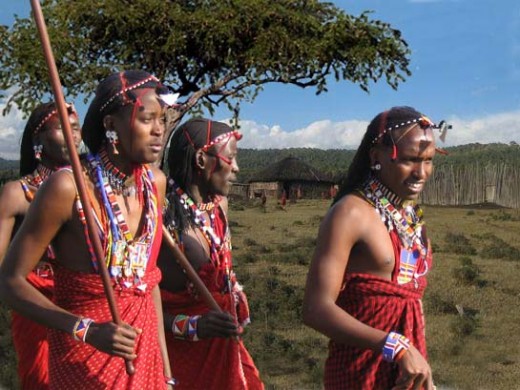
Image: © 2001 Rob Hemphill
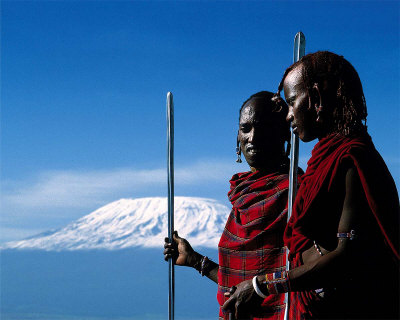
Masai Warriors, Ambosiele Park, Kenya
Kenya's "Big Five" Animals
The worlds top safari country
The "Big Five" are the 5 animals (lion, rhino, leopard, elephant and buffalo) anybody who's going on a safari hopes to spot. One other reason why these animals are classed together is their original status as "game animals" for hunting. This is why popular animals such as the giraffe or hippo are not part of the Big Five despite their widespread populations, and beautiful sight.
Many Kenyan animals are endangered or threatened so hunting is not as prevalent as it once was. Going on a safari meant going on a hunt but now in most cases, the rifle shots have been replaced by photo shots.
- LION - Lion prides can be found in several parts of Kenya, especially in the savannah and grassland regions in the southwestern part of the country. The best wildlife parks to find lions are the Masai Mara National Reserve, East and West Tsavo National Parks as well as the Samburu National Reserve.
Lion numbers were once in excess of 10,000 actually living in Kenya, but those have dwindled to as few as 2,000 now. They face numerous threats, including poaching, poisoning by local farmers (who wish to stop lions from attacking their cattle), and the traditional Masai coming-of-age tradition of boys spearing and killing a lion in order to become a warrior.
- RHINO - The Rhino is far more scarce than the majority of abundant animals of Kenya. Again, poaching for their unusual horns has drastically reduced their population.
The black rhino and the white rhino are the two species found in Kenya. There is a black rhino sanctuary at the Lake Nakuru National Park, where rhinos can be seen, albeit in a protective environment. Rhino herds are also often seen at the Meru National Park, and sometimes at the Masai Mara Reserve.
- LEOPARD - Leopards are the smallest of the big cats and look similar to the heavier jaguar. As with most big cats, the leopard is widely hunted and poached for its pelt, which has begun to threaten the species. Their habit of dragging kills up into trees can make for terrific photo opportunities, and at least the tourists are not there to harm the animals. Leopards often bring down animals considerably larger than themselves, like antelope or wild boar. They can be seen at a number of parks, particularly the Masai Mara or Samburu National Reserves.
- ELEPHANT - The African elephant is bigger than the Asian elephant and has large flapping ears, unlike the Asian elephant with its smaller ones. Like the rhino, it is unfortunately hunted for its tusks, so it's very much a protected species. East Africa is one of the few areas where the elephant is thriving, and numbers are even growing.
Elephants travel in herds, and can be very destructive to the trees and vegetation when their population gets too large. In Kenya, elephants are live in either the savannah grasslands or in the forested areas.
- BUFFALO - African buffalo are large herd animals and found in specific regions of Kenya from the grasslands, to the floodplains and forests. They are extremely dangerous towards humans, and many people are gored to death by African buffalo each year. Along with the hippopotamus, buffalo considered to be amongst the most dangerous animals in Kenya.
Marsabit National Park and Mount Kenya National Park are excellent locations for sighting African buffalo; however, they are not considered to be endangered at present.
The Rough Guide to Kenya

Extraordinary Birdlife
Bird sounds were always all around
My memories are of a wonderfully diverse birdlife, all colours and sizes from the tiny hovering hummingbirds and fruit-stealing mousebirds to the elegant flamingos standing tall in the salt laden shores of Lake Naivasha.
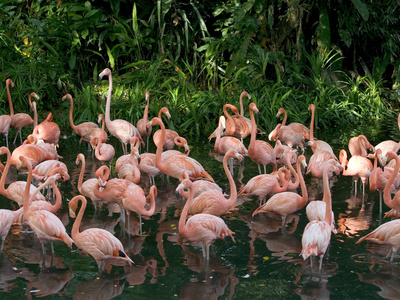
A Group of Greater Flamingos
Wade in the Shallow Water of Lake Nakuru
Kenya has a vast variety of bird species, over 1000, in a vast variety of habitats. From mountain forest to tropical coast, in every conceivable altitude range: deserts, open savannah grassland, lowland forest, bush and scrub, lakes and mudflats.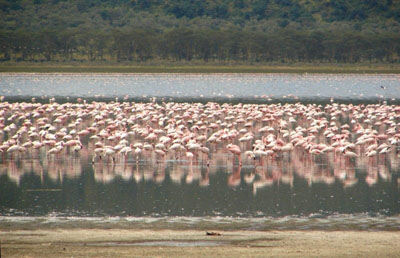
Flamingos on Lake Naivasha
Due to the lack of climatic extremes there is a massive variety of birds in Kenya. As the equator goes right through the country, there is no summer or winter as such - but only wet and dry seasons. Huge numbers of birds migrate south from the northern latitudes to avoid the harsh oncoming winters. The birds come in their millions to East Africa from the Bering Straits in the east to the northern tip of Norway in the west. It has been estimated, that as many as 6,000 million birds - give or take a few million - make the journey each year. Combining the migratory birds with the amazing variety of local birds, you have an ornithological paradise.Hummingbirds can hover in mid-air by rapidly flapping their wings at between 15 and 80 times per second (depending on the species). They can fly backwards, and are the only group of birds able to do so. Quite obviously, their name comes from the characteristic hum made by their wings at high speed.
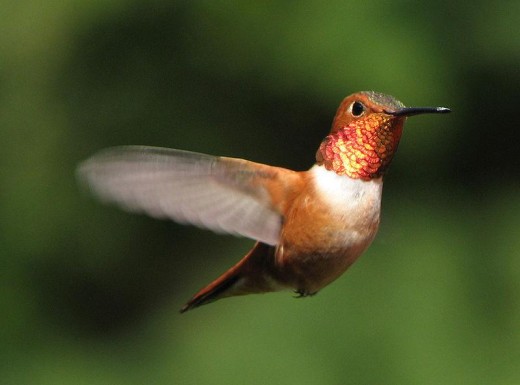
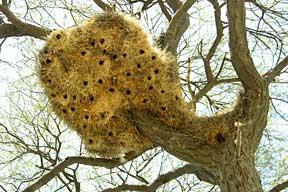
Weaver birds are seed-eating birds with rounded conical bills, and most breed in sub-Saharan Africa.
Weaver birds, also known as weaver finches, are well named due to their ability to weave elaborate nests (the most elaborate of any birds'). The nests come in all shapes and sizes, with a host of different materials being used, and even construction techniques vary from species to species. Nests can be built out of fine leaf-fibers, grass and twigs, and many species will weave very fine nests using thin strands of leaf fiber. Though some, like the buffalo-weavers, form large, untidy stick nests in their colonies, which might have spherical woven nests within. The sparrow weavers of Africa construct apartment-style nests, in which 100 to 300 pairs will have separate flask-shaped chambers with an entrance by tubes at the bottom. Most species weave nests that have narrow entrances, facing downward, which makes it difficult for snakes to enter.
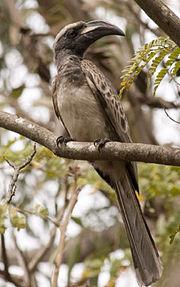
Hornbills, found in tropical and sub-tropical Africa, are characterized by a long and frequently brightly-coloured, downward curved bill. They are the only birds where the first two neck vertebrae are fused together; perhaps this provides a more stable platform for carrying the bill. They are unable to swallow food caught at the end of the beak as their tongues are just too short to manipulate it, so they simply toss it back into the throat with a jerk of the head. They feed on a variety of fruits, especially figs and small animals. I recollect watching a neighbour feeding live snakes to his friendly hornbill and seeing them be dispatched and swallowed with utter precision. The birds are monogamous in their breeding habit, and they nest in natural cavities in trees and occasionally in cliffs.
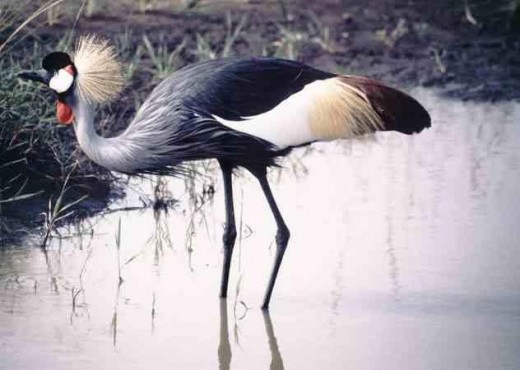
Photo credit: Wikipedia
The Grey Crowned Crane lives in dry savannah in areas of Africa south of the Sahara, although they nest in considerably wetter habitats.
It has a breeding display involving dancing, bowing, and jumping, and has a loud, booming call which it does by inflating its red gular sac. The honking sound it makes is very different to the trumpeting sounds made by other crane species.
The Crane stands about 1 m (3.3 ft) tall and weighs in at 3.5 kg (7.7 lbs) and has a mainly grey body plumage. The wings are also predominantly white but also contain feathers with a wide range of colours. On the head is a crown of stiff golden feathers, and the sides of the face are white with a brightly coloured red inflatable throat pouch. The grey bill is fairly short, and the long legs are black. Both sexes are similar, although females tend to be slightly smaller. Young birds are different to adults as they are greyer with a feathery buff face. Like all cranes, they feed on insects, reptiles and small mammals.
The Grey Crowned Crane is the national bird of Uganda, and it also features in the country's flag and coat of arms.
African Birds Are Beautiful, But...
This lens is packed full of some glorious imagery of a small sample of the birds of Africa, but there is a slight downside to the story.
What is it? Pop over and see, and PLEASE vote in the poll half way through.
Birds of Kenya and Northern Tanzania

Kenya has it's own Indigenous Menus
Different Communities have different menus unique to their livelihood
Kenya is made up of many tribes, and each tribe has a specific food or way of making food that is very different from the other tribes. It is only when you get to the Indian Ocean that you can see a good variety of fruit and vegetables. Unfortunately, Kenya exports so much of its produce, which means that there is a lot of poverty throughout the country.
"You couldn't have come to Kenya for the food!" is a common reaction of many visitors when asked about Kenyan food.
Here are a few examples:
Ugali and Fish
Ugali is made by grinding maize, then adding flour and water. It takes the form of a cake after it has been cooked. The flour is cooked in boiling water until it hardens. This is a favourite meal not only for the Luos in Nyanza Province, but for all Kenyans. Fish is popular in Nyanza because of it's proximity to Lake Victoria and at the coast because of the Indian Ocean.
Githeri
This is a mixture of boiled maize and beans, and is a popular dish among the Kikuyu community mainly found in Central Province.
Mukimo
This is a mashed version of the Githeri. It is usually made up of maize and beans mashed with potatoes or cooked bananas.
Mursik
This is a popular drink made of fermented milk and charcoal popular among the Kalenjins of Kenya.
Ingoho
The Luhya's of Western Kenya are said to love this meal that is basically chicken. Luhya's are sure to cook for you Ingoho if you are considered an important visitor.
Wali
At the cost, Wali (Rice) is a popular meal. It is mostly cooked with coconut milk. Coconuts are readily available at the cost.
Kachumbari
This is a mixture of chopped tomatoes, onions, pepper, parsley and in some cases Avocado. It is mostly served with Nyama Choma.
Nyama Choma
This is roast meat. Very popular in Kenya. Beef is the cheaper meat in Kenya compared to Chicken or Fish.
Swahili - The Language
Swahili, or Kiswahili as it's called in the language itself, is the first language of the Waswahili (Swahili people). These people live in several large stretches along the Indian Ocean coastline, from the southern part of Somalia to northern Mozambique. Swahili is the primary language of much of East Africa, although only 5 to 10 million people speak it as their native language. It is the official language of four nations and is the only language with an African origin among the official working languages of the African Union.
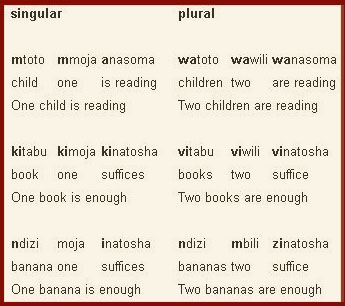
Although originally written in Arabic script, Swahili orthography is now based on the Latin alphabet that was introduced by Christian missionaries and colonial administrators. The text shown here is the Catholic version of the Lord's Prayer.
"Kiswahili" is the Swahili word for the Swahili language, and this is also sometimes used in English.
To the right is an example on how a sentence is constructed.
Photo Credit: Wikipedia
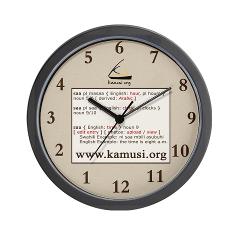
Swahili Time (East African) Swahili time runs from dawn to dusk, rather than midnight to midday. 7am and 7pm are therefore both one o'clock while midnight and midday are six o'clock. Words such as asubuhi 'morning', jioni 'evening' and usiku 'night' can be used to demarcate periods of the day, for example:
* saa moja asubuhi ('hour one morning') 7:00 a.m.
* saa tisa usiku ('hour nine night') 3:00 a.m.
* saa mbili usiku ('hour two night') 8:00 p.m.
More specific time demarcations include adhuhuri 'early afternoon', alasiri 'late afternoon', usiku wa manane 'late night/past midnight', 'sunrise' macheo and sunset machweo. At certain times there is some overlap of terms used to demarcate day and night, e.g. 7:00 p.m. can be either saa moja jioni or saa moja usiku.
Other relevant phrases include na robo 'and a quarter', na nusu 'and a half', kasarobo/kasorobo 'less a quarter', and dakika 'minute(s)':
* saa nne na nusu ('hour four and a half') 10:30
* saa tatu na dakika tano ('hour three and minutes five') five past nine
* saa mbili kasorobo ('hour two less a quarter') 7:45
* saa tatu kasoro ('a few minutes to nine')
Swahili time derives from the fact that the sun rises at around 6am and sets at around 6pm everyday in most of the equatorial areas where Swahili speakers live.
Dictionaries:
Automatic translation:
Live stream:
Other Links
Famous Names with a Kenya Connection
Louis Leakey is a Kenyan archaeologist and naturalist, whose work was highly important in establishing the evolution of human development in Africa. He also played an important role in protecting African wildlife and created organizations specifically for future research there. Having been involved in establishing a tradition of palaeoanthropological inquiry, he was able to motivate the next generation to continue it, most notably within his own family. Louis took part in national events of British East Africa, and subsequently Kenya, in important even if less spectacular ways.
In natural philosophy, he asserted Charles Darwin's theory of evolution unswervingly and set about to prove Darwin's hypothesis that man arose in Africa.
As a Christian and a religious man, he said:
"Nothing I've ever found has contradicted the Bible. It's people with their finite minds who misread the Bible."
Richard Leakey is a Kenyan politician, conservationist and paleoanthropologist. He is the second son of three of the archaeologists Louis and Mary Leakey.
Richard was a very independent young man who borrowed £500 from his parents to buy a Land Rover, and went into business trapping and supplying skeletons with Kamoya Kimeu. Already a skilled horseman, archaeologist, Rover mechanic, expedition leader and, he learned to identify bones, skills which all pointed to a path he did not yet wish to take, simply because his father was on it.
The bone business turned into a safari business in 1961. In 1962, he obtained a private airplane pilot license and took tours to Olduvai. He went looking for fossils with Glynn Isaac, and his father was so impressed with their finds that he gave them National Geographic money for a month's expedition.
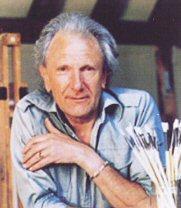
David Shepherd is an artist and conservationist who has spent much of his life painting the wildlife in Kenya, particularly elephants. He founded the David Shepherd Wildlife Foundation in order to combat the severe poaching problem in the country after coming across 255 dead zebra at a watering hole.
Read more here...
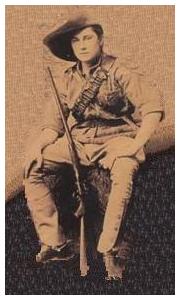
Ewart Grogan became the first European to traverse the African continent from Cape Town to Cairo at the end of the nineteenth century.
He undertook this trek in order to impress the family of a Miss Gertrude Coleman-Watt, with whom he had fallen in love. Although he started out with a companion - Harry Sharp - by the time he completed his exploit in 1900 he was on his own.
The achievement had the desired effect as he and Gertrude were later married.
Wildebeest Migration Poster
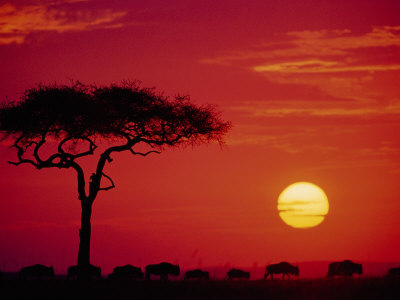
Top Kenyan Athletes
Kenya has produced a string of world class athletes and continues to do so. Their ability to run well at altitude gives them a great advantage on the athletics field.
At the Mexico City Olympics in 1968 Kipchoge Keino and Ben Jipcho finished first and second in the steeplechase. Perhaps the most remarkable feat ever achieved by a Kenyan was Henry Rono's 5 records in 50 days achieved in 1978 when he set a world record in every track event from the 800m to the 10,000m.
Kenya did not participate in either the 1976 or the 1980 Olympics.
At the Seoul Olympics of 1988, Kenya's track team won four gold medals in what was Kenya's most memorable performance.
* John Nugget finished nearly 100 meters ahead of the field in 5000 meters.
* Julius kariuki and Peter Koech finished first and second in the steeplechase.
* Peter Rono won the 1500m in spectacular fashion.
* Nixon Kiprotich and Paul Ereng gave a clinic in teamwork to ensure that Ereng won the 800 meters gold medal.
At the 1992 Barcelona Olympics, Kenya completed a clean sweep of the steeplechase, led by Mathew Birir.
* Susan Sirma became the first Kenyan woman to win an Olympic medal when she won a bronze in the 1500 meters.
* Samson Kitur became the first Kenyan to win a medal in a sprint event when he finished third in the 400 meters.
* William Tanui and Nixon Kiprotich finished first and second in the 800 meters.
* Sally Barsosio became the first Kenyan woman to win a world title when she won the 10,000 meters at the World championships of 1997.
Besides dominating the track, Kenyan athletes notably John Ngugi and Paul Tergat have dominated the world cross country championships, winning the team title consecutively for more than a decade. Athletes such as Moses Tanui, Ibrahim Hussein and Cosmas Ndeti have stamped their names on prestigious marathons all over the globe, such as the New York marathon and the London Marathon. Kenyan athletes have also dominated big money road races worldwide, leading to resentments by other athletes and sponsors who tried to bar Kenyans from competing in such races.
Elijah Lagat is among the latest Kenyan track sensations having won the Boston marathon in 2000.
Kenyan women, who for years were unable to match the men, have come up strong with several Kenyan women winning marathons and road races all over the world. Tagla Lorupe is now the world record holder in the womens marathon. Catherine Ndereba won the Boston marathon in 2000.
At the 2000 Beijing Olympics Kenya won two gold medals courtesy of Noah Ngeny and Reuben Kosgei,
But it was at the world Junior track and field championships that Kenya stole the show, winning seven gold medals to finish at the top of the medals table, Kenya's best performance ever, a sign that there is still abundant talent coming through the ranks.
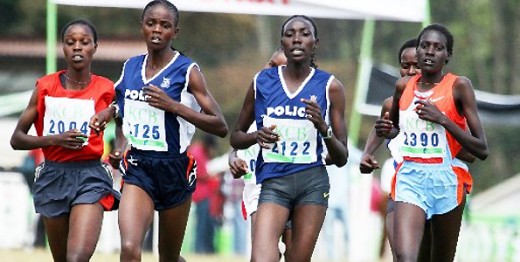
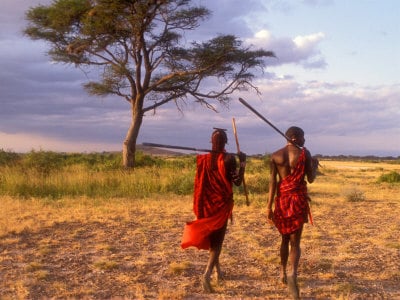
Kenyan Proverbs A-H
A baboon (monkey) laughs at the buttocks of another baboon.
A black ant will not bite another (black ant).
A champion bull starts from birth.
A child does not fear treading on dangerous ground until he or she gets hurt stumbles.
A child points out to you the direction and then you find your way.
A debt between children born by the same mother is paid in a clever way.
A donkey always says thank you with a kick.
A friend is someone who knows the song in your heart and can sing it back to you when you have forgotten the words.
A fully grown up tree cannot be bent into a walking stick.
A good person once you shelter with him under the bush you will know him, and bad one as well.
A hyena cannot smell its own stench.
A lone runner says he has legs (runs fast).
A messenger cannot be beaten.
A person changing his clothing always hides while changing.
A rat-trap catches both the guilty and the innocent.
A rope parts where is thinnest.
A sinking ship doesn't need a captain.
A slave has no choice.
A true person is the one who gives birth to a foolish child.
A woman's stomach does not grow if she is not pregnant.
A word in the heart does not win.
All cassavas have the same skins but not all taste the same.
All monkeys cannot hung on the same branch.
An empty pot makes the loudest noise
An old pot never lacks food remains.
An orphaned calf licks its own back.
Bad dancing does not brake an engagement.
Bartered grains do not fill up the granary.
Blessings are better than possessions.
Bow-legged person does not hunt antelopes.
Burning charcoal is turned into ashes.
Competition exhausted the lungs.
Cut your nose to save your face.
Dip after dip depletes a jar of honey.
Do not follow a person who is running a way.
Even a friend can not rescue one from old age.
Even an expert swimmer drowns.
Even if you bewitch in the night, you will be known.
Even the small leopard is called leopard.
Every bird flies with its own wings.
Every door has its own key.
Feet cannot stop one from going into danger.
Follow bees and get honey.
Good things sell, bad things advertise.
He who does not know one thing knows another.
He who is unable to dance says the yard is stony.
He who refuses to obey cannot command.
He who wants what is under a bed must bend over to get it.
He whose seeds have not germinated does not put down the seed container.
Help yourself and God will help you.
How easy it is to defeat people who do not kindle fire for themselves.
How gently glides the married life away, when she who rules still seems but to obey.
However much it rains on you, no wild banana tree will grow on your head.
Mount Kilimanjaro - Highest mountain in Africa
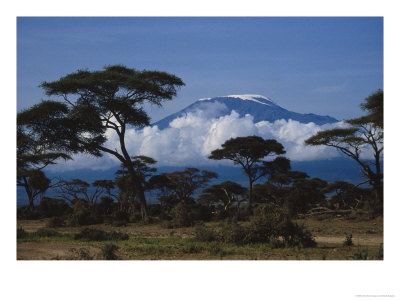
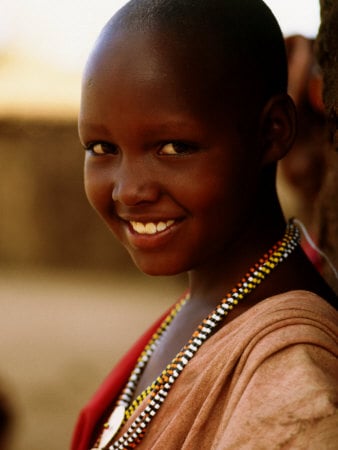
Kenyan Proverbs I-S
I shall come for the cows after the donkeys have grown horns (never).
If it doesn't resemble dad, it resembles mum.
If you do not know death, look at the grave.
If you want to kill a monkey, avoid looking him in the eyes.
If one is roasting two potatoes, one of them is bound to get charred.
Intelligence is like hair, everyone has its own.
It is better for the eye to die than the heart.
It is better to be poor when one is young, rather than becoming poor at old age.
It is the grass that suffers when elephants fight.
Misery loves company.
Nine is nearly ten.
No length without end.
No masika (rain season) without mosquitoes.
No one can perform a celebration by himself.
No water without waves.
Of five fingers, which is the best?
One does not throw away one's old praying mat just because of a new one that one has borrowed.
One finger does not kill a louse.
One in the woodpile does not laugh at the one in the fire.
One person is thin porridge or gruel; two or three people are a handful of stiff cooked cornmeal.
One who relates with a corrupt person likewise gets corrupted.
One whose seeds have not sprouted does not give up planting.
Only a medicine man gets rich by sleeping.
Only someone else can scratch your back.
Peace is costly but it is worth the expense.
Regular work tires a woman but totally wrecks a man.
Someone relative is blood of the tongue, some you spit out and some you swallow.
Stream, it knows where to flow.
Suppression of hunger leads to death.
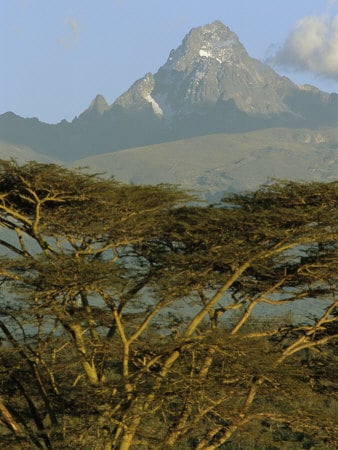
Kenyan Proverbs T-Z
The abundance of fruit caused the death of the fruit lover.
The alarm from the other house does not prevent one from eating.
The big fish eats the smaller one.
The blame of the antelope is on the hunter.
The brewer dilutes the beer if over-praised.
The celebration does not last forever.
The chaser and the one who is chased get tired.
The curse of the fowl does not bother the eagle.
The devil turns against its friend.
The eye is a coward.
The eyes of the in-law belittle what they have seen.
The fire burns the fire maker.
The fool hides what would eat him.
The hen pecks and wipes its beak.
The man may be the head of the home; the wife is the heart.
The mouth wronged the walker.
The one chased away with a club comes back, but the one chased away with kihooto [reason] does not.
The one who has been attacked by a buffalo, is afraid when he sees a black cow.
The one who is praised, comes forth to chant.
The possessor may become dispossessed.
The rat does not help the other rat to peel a piece of maize.
The stick in the hand kills the snake.
The strength of a hero does not centre on his buttocks.
The thing that kills someone is small.
Those who arrive to the spring first, drink the purest water.
Three can keep a secret when two died.
Two guests cannot be entertained satisfactorily at the same time.
Water never flows up the mountain.
We add wisdom to knowledge.
We have not inherited this land from our ancestors; rather we have borrowed it from our children.
We should put out fire while it is still small.
What bites you is in your clothes.
When he hangs himself down like a bat, he definitely knows how he would float through the air.
When the lion cannot find meat, it eats grass.
When the rock is not around, the small stone sits there.
When you mention the person with one eye, the one with the eye problem reacts.
When you spread it in the sun, it becomes dry.
Who thinks to stay should take care not to fall.
Who walks slowly will also reach the aim.
You cannot take away someone's luck.
You don't teach a grown up monkey how to climb a tree.
You only make a bridge where there is a river.
You should never forget your neighbour when you invite people to come to the feast.
You suffer from smoke produced by the firewood you fetched yourself.

All the proverbs above are from Kenya-Advisor.com, so if you want to find out more, have a look at their great site.
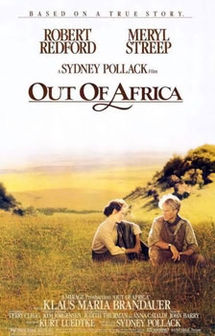
Films Made in Kenya
Out of Africa, the 1985 film starring Meryl Streep and Robert Redford was shot in Kenya and revealed Kenya's colonial history in romantic drama film. It retold the story of Danish author's Karen Blixen's love affair with Kenya and Hunter Denys Finch Hatton in particular.
"I had a farm in Africa at the foot of the Ngong Hills..."
More here...

To Walk with Lions was a 1999 film based on the book of the same title by George Adamson starring Richard Harris as Adamson and John Michie as Tony Fitzjohn.
Adamson spends the latter part of his life protecting the lions and other wildlife in the Kora National Reserve, Kenya. He encounters poachers and government corruption blocking his quest for wildlife preservation.
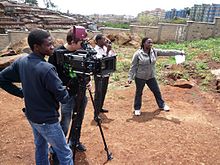
The Oath is a fictional short film set in 1950s Kenya during the Mau Mau uprising under British colonialism. It portrays the struggle between two brothers on opposite sides of the conflict. Many of the actors in the film were descendants of Mau Mau fighters. It was produced with their input, as an educational tool at a time when Mau Mau was less appreciated in Kenyan society than it is today. It received a lot of criticism for its balanced and positive portrayal of the Mau Mau and their struggle for independence from the British.
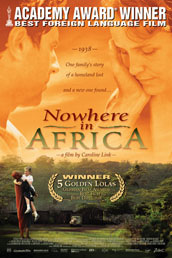
Nowhere in Africa 2003, won an Oscar for Best Foreign Film that year.
'Nowhere in Africa' tells the story of a Jewish family who flee Adolf Hitler's Nazi Germany in the 1930s to live on a remote farm in Kenya. The couple find the transition challenging, which puts their relationship under serious strain. However, their young daughter, Regina, settles in well, making good friends with Owuor, the family's cook.
The German producer, Peter Hermann, and director, Caroline Link, were determined to make an authentic film, and to shoot it in Kenya, where Stephanie Zweig's autobiography is set, rather than being forced to make the film in the more technically advanced studios in South Africa.
During the Kenyan struggle for independence from the British in the late 1950s, a scientific safari led by Ernest Hemingway undertakes the ascent of Mount Kenya. Hemingway has been warned by Kikuyu tribe members not to violate the sacred laws of Mwene-Nyaga, the mountain's god, by harming the elephants which ascend its peaks because it will lead to self-destruction, as any aggression against against nature is an act of suicide. The expeditions consists of the author, Alex Smith, British police commissioner, Renata, the photographer and Hemingway's lover, Antonio, Hemingway's godson, a Spanish biologist and frustrated bullfighter, Kamau, a Kikuyu tribe member who secretly fights for Kenya's independence with the Mau-Mau rebels. The expedition's progress is impeded as political and personal forces collide and Hemingway comes face-to-face with his final destiny in facing the decision to shoot the Sacred Mammoth who roams the highest peaks of Mount Kenya.
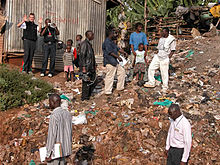
Kibera Kid is a 2006 seven-award winning fictional short film set in the Kibera slums in Nairobi, one of the largest slums in Africa. It was written, directed and co-produced by Nathan Collett in collaboration with the youth of Kibera. This twelve minutes film features Kibera actors in all the principle roles. It has played at film festivals worldwide including the Berlin Film Festival and it won a Student EMMY from Hollywood. It has been profiled by BBC, Reuters, Al Jazeera English and many others.






